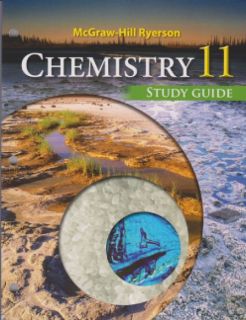Suppliers
Other Departments
Shop by Brand
More Information
.png)

Suppliers > McGraw-Hill Co. The
McGraw-Hill Ryerson Chemistry 11 - Study Guide / Workbook
Model: 9780071050951
The McGraw-Hill Ryerson Chemistry 11 - Study Guide / Workbook supports the Ontario Ministry of Education
course: Chemistry, Grade 11, University Preparation, Course Code: SCH3U
It follows the student textbook and has reviews or practice problems on these units and chapters:
Unit 1 Matter, Chemical Trends, and Chemical Bonding
- Elements and the Periodic Table
(The Atoms, Average Atomic Mass, The Periodic Table, Atomic Radius, More Periodic Trends)
- Chemical Bonding
(Chemical Bonds, Covalent Bonds, Writing Names and Formulas [for Ionic Compounds, Bases and Acids, Binary Molecular Compounds],
Forces Between Particles in a Compound)
Unit 2 Chemical Reactions
- Synthesis, Decomposition, and Combustion Reactions
(Describing Chemical Equations, Writing Skeleton Equations, Balancing Chemical Equations, Synthesis Reactions, Decomposition Reactions, Combusiton Reactions)
- Displacement Reactions
(Characteristics of Single Displacement Reactions, Using the Activity Series of Metals and Halogens, Predicting Products of a Single Displacement Reaction, Characteristics of Double Displacement Reactions, Types of Double Displacement Reactions, Predicting Products of a Double Displacement Reaction)
Unit 3 Quantities in Chemical Reactions
- The Mole: A Chemist's Counter
(The Avogadro Constant and the Mole, Converting Amount (in Moles) to Number of Particles and Back, Mass and The Mole, Converting Amount (in Moles) to Mass and Back, Converting Number of Particles to Mass and Back)
- Proportions in Chemical Compounds
(The Law of Definite Proportions, Percentage Composition, Empirical and Molecular Formulas, Determining Molecular Formulas, Hydrates)
- Chemical Reactions and Stoichiometry
(What is Stoichiometry?, Mass Relationships in Chemical Reactions, Limiting and Excess Reactants, Theoretical Yield and Actual Yield)
Unit 4 Solutions and Solubility
- Solutions and Their Properties
(What is a Solution?, Temperature, Pressure, and Solubility, Concentrations of Solutions, Molar Concentrations, Preparing a Standard Aqueous Solution)
- Reactions in Aqueous Solutions
(Net Ionic Equations and Qualitative Analysis, Solution Stoichiometry, Water Quality, Water Treatment)
- Acids and Bases
(Acids and Bases, Strong and Weak Acids and Bases, Neutralization Reactions and Acid-base Titrations)
Unit 5 Gases and Atmospheric Chemistry
- Properties of Gases
(Physical States and Their Properties, The Kinetic Energy of Particles and Temperature, Gases and Pressure Changes, Boyle's Law: Pressure and Volume, Charles's Law: Volume and Temperature, Gay-Lussac's Law: Temperature and Pressure)
- Exploring the Gas Laws
(The Combined Gas Law, Combining Volume of Gases, Avogadro's Law, and Molar Volume, The Ideal Gas Law, Density and Molar Mass, Dalton's Law of Partial Pressure, Non-Ideal Gas Behaviour)
Answers are given at the end of the workbook.
256 pages




